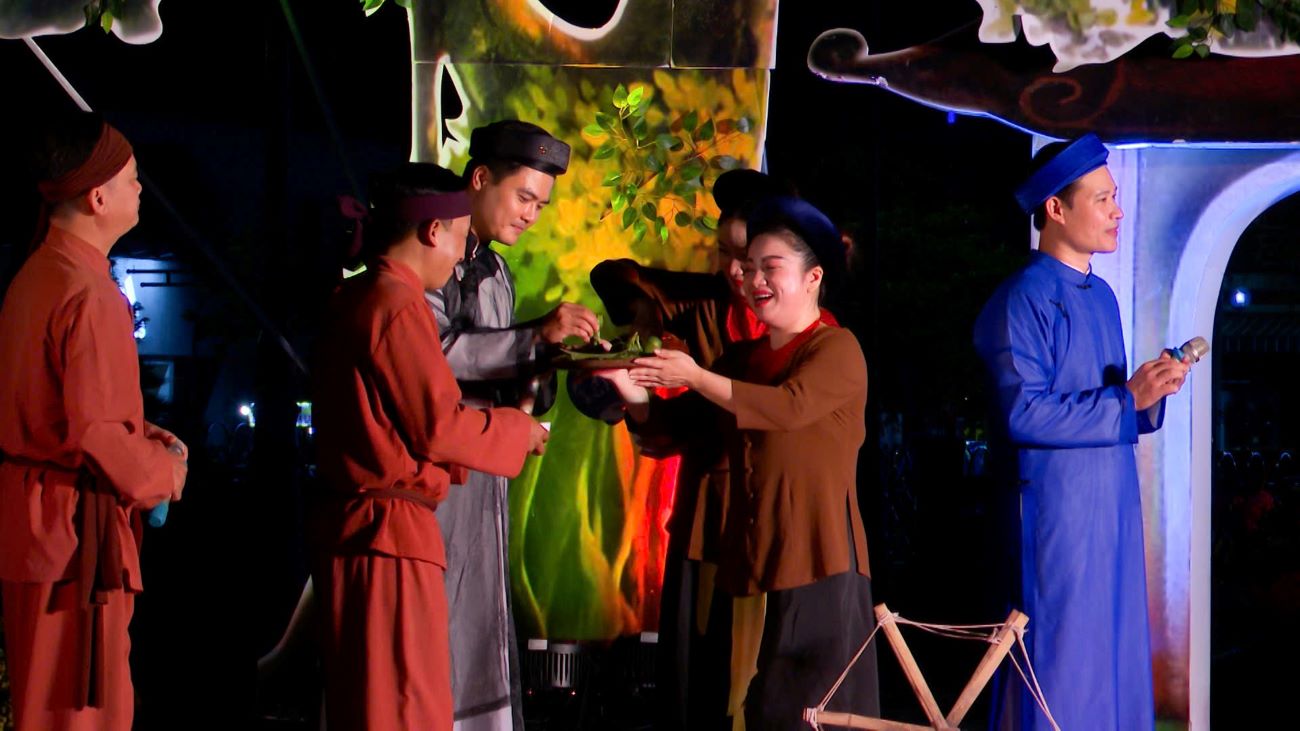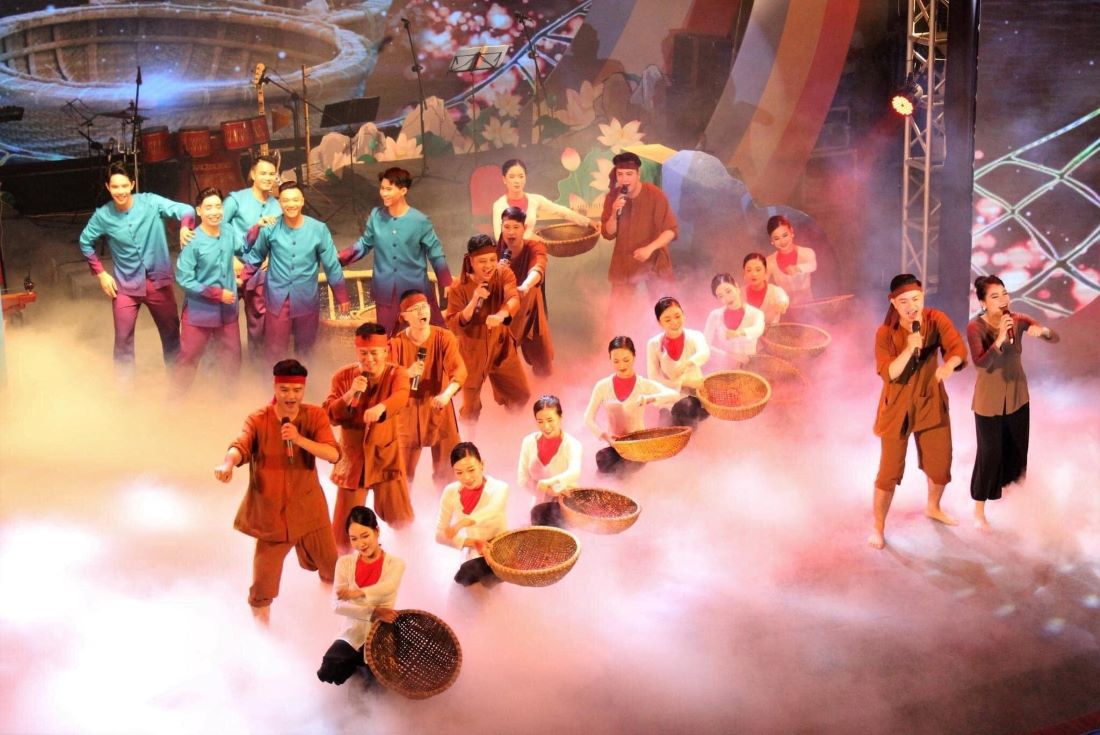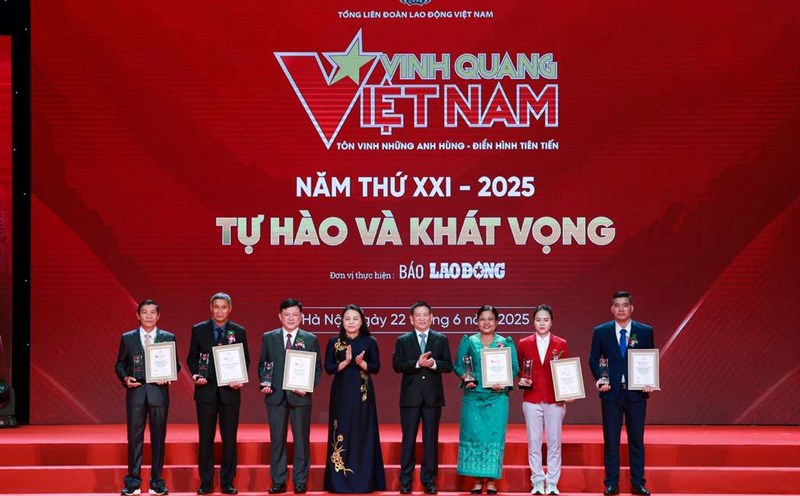Join hands to preserve and promote heritage
As someone who grew up in the cradle of Nghe Tinh's Vi and Giam and achieved many successes from composing lyrics to performing this unique folk song genre, People's Artist Hong Luu - former Director of the Center for Preservation and Promotion of Nghe An's Folk Song Heritage - was very moved and proud when talking about the heritage value after 10 years of being honored by UNESCO as a representative intangible cultural heritage of humanity.
People's Artist Hong Luu shared: “Over the past 10 years, the government, people, and artisans of Nghe An and Ha Tinh provinces have joined hands to contribute to spreading the heritage of their homeland both domestically and internationally. Many important mechanisms and policies have been issued and implemented as a basis for protecting and promoting the value, affirming the position and influence of Vi and Giam melodies in the community. This is a solid foundation for Vi and Giam to continue to be preserved and promoted better in the future.”
Artist Hong Luu will always remember the moment at 11:05 p.m. on November 27, 2014, in Paris, France, when UNESCO recognized Nghe Tinh Vi and Giam folk songs as a representative intangible cultural heritage of humanity. In addition to the previously recognized intangible cultural heritages such as: Southern amateur music, Xoan singing, Ca Tru, Quan Ho folk songs, Central Highlands Gong Cultural Space..., up to that time, Nghe Tinh Vi and Giam folk songs were the 9th intangible cultural heritage of Vietnam recognized by UNESCO.

UNESCO recognized that Vi and Giam folk songs - a type of unaccompanied singing of farmers in the North Central region of Vietnam - have expressed the unique cultural identity of rural villages in Vietnam. Vi and Giam folk songs of Nghe Tinh satisfy the criteria of being a cultural phenomenon with a long-standing tradition, uniqueness and representativeness, rooted in the heart of the community, protected and promoted by the community through many generations.
Over the past 10 years, Nghe Tinh Vi and Giam folk songs have spread more widely in the community, especially in the two provinces of Nghe An and Ha Tinh. Immediately after Vi and Giam folk songs were recognized as intangible cultural heritage of humanity, Nghe An province has taken practical activities to preserve and promote the value of this type of cultural heritage.
Notably, the Provincial People's Committee issued a Project to protect and promote the value of Vi and Giam folk song heritage for the period 2021 - 2025; accordingly, the Department of Culture and Sports coordinates with localities to advise on the implementation of the project's contents such as research, collection, inventory, documentation, digitization of Vi and Giam folk songs, development of clubs and artisans, teaching and promoting the value of the heritage...
In addition, the province also has special policies related to the protection and promotion of the value of the Vi and Giam folk heritage, such as the issuance of Resolution 29/2021 of the Provincial People's Council stipulating support policies for artisans, clubs in the field of intangible cultural heritage and artists working at the Provincial Traditional Arts Center, thereby contributing to encouraging and motivating the active role of artisans as well as clubs in preserving and promoting heritage, including the Vi and Giam folk songs of Nghe Tinh.
From 82 folk song clubs at the end of 2014, the province now has 140 Vi and Giam folk song clubs in 20 districts, cities and towns with a total of more than 3,000 members. In many localities, the activities of Vi and Giam folk song clubs have been very exciting, contributing positively to the local cultural and artistic movement. In addition, the province has 48 Vi and Giam folk song artists who were awarded the title of Meritorious Artist by the President, and 1 artist was awarded the title of People's Artist.
In Ha Tinh, since the Vi and Giam folk songs were honored, the network of clubs in districts, cities and towns has been continuously expanded. If in 2015, the whole province had 92 clubs in 15 districts, cities and towns, by 2023 there were more than 130 clubs in all 21 districts, cities and towns with a total of about 2,500 members of many ages and professions participating in activities. In other provinces, there are also Vi and Giam clubs in Hanoi and Vi and Giam clubs in Nghe Tinh in the South.
To keep the Giam poem alive forever
Although many remarkable results have been achieved, in the contemporary society of Nghe An in particular and the whole country in general, the existence and development of Vi Giam folk songs are facing many difficulties and challenges.
As a researcher, collector, and composer of Vi Giam melodies, the excellent artisan Nguyen Ban (Ha Tinh) pondered: “Nowadays, plowing and cultivating are almost all done by machines, while the craft villages have faded away, and all remaining crafts have been industrialized, with mainly mechanical tools.
Regarding people, in the past, villages had dozens of beautiful and talented men and women in each village. Nowadays, the scale of villages and residential areas has many more households than the old villages, but it is difficult to find a few young men and women. When the village boys and girls grow up, finish school and go to work, so the restoration and promotion of performance spaces for experimentation should also stop to find new spaces suitable for today's community cultural activities.
People's Artist Hong Luu also has a similar perspective, worrying about the future of Vi Giam when its traditional performance space has faded away, changing too much compared to before.
From the perspective of the youth's approach psychology, Meritorious Artist Tran Van Sang (Ha Tinh) shared: "In the context of deep cultural integration today, modern music genres and entertainment forms are developing rapidly, have strong appeal, and attract the majority of young people and children; many young people do not know and are not very interested in folk songs and folk songs".

According to artisan Van Sang, the Vi and Giam folk song clubs in the localities mostly attract older members, the number of young people participating is very small; operating costs are mainly contributed voluntarily by club members, so regular maintenance is difficult; the team of cultural officers in some localities do not have the deep expertise to practice teaching and popularizing folk songs to the young generation. The team of young artisans who are knowledgeable, passionate, and responsible for Vi and Giam folk songs is very small.
From the above situation, the goal of preserving and promoting the value of Vi Giam folk song heritage requires great efforts from the whole community.
According to Vice Chairman of Nghe An Provincial People's Committee Bui Dinh Long, in order for Nghe Tinh Vi and Giam folk songs to be worthy of the status of representative intangible cultural heritage of humanity, the authorities and people of Nghe An and Ha Tinh provinces will continue to implement the Action Program to protect and promote the value of Nghe Tinh Vi and Giam folk songs, creating conditions for artisans and the community to preserve, pass on, and spread love for the heritage; increase investment in resources, gradually build Nghe Tinh Vi and Giam folk songs into a typical tourism product of Nghe An, invest in building a brand for Vi and Giam and a local tourism brand associated with Vi and Giam.
“The government and people of Nghe An and Ha Tinh provinces will continue to promote their roles and responsibilities, with a proud spirit of spreading the heritage of their homeland, resounding far and wide, to bring Nghe Tinh folk songs to many new lands, integrating and converging with the quintessence of national culture. So that when each person returns to Nghe An, their soul will be immersed in the full folk songs, cultivating and gradually growing their love for this land filled with love for the land and people” – Mr. Bui Dinh Long shared.
(Posted in the special publication of Lao Dong Bac Mien Trung Xuan At Ty)











